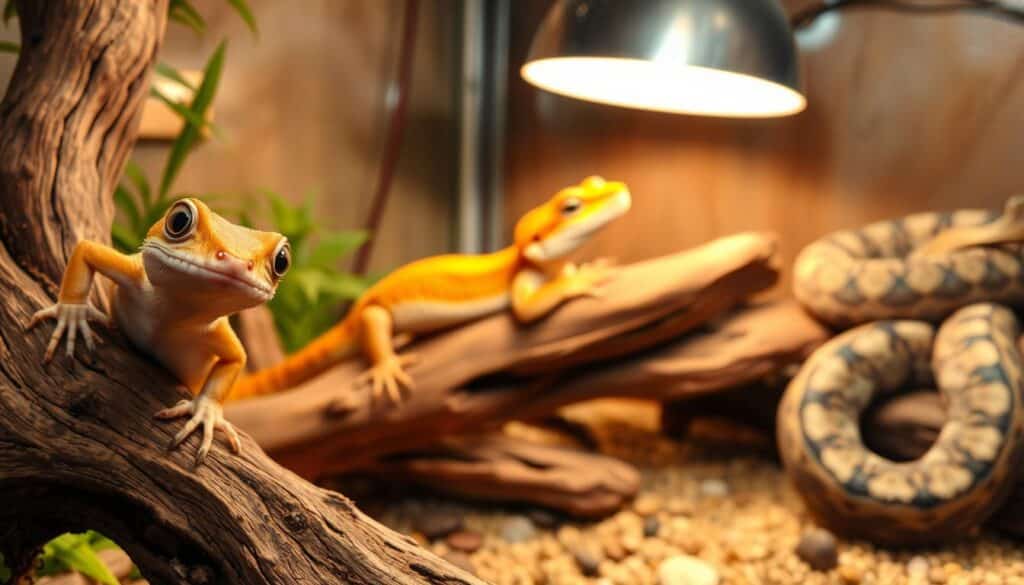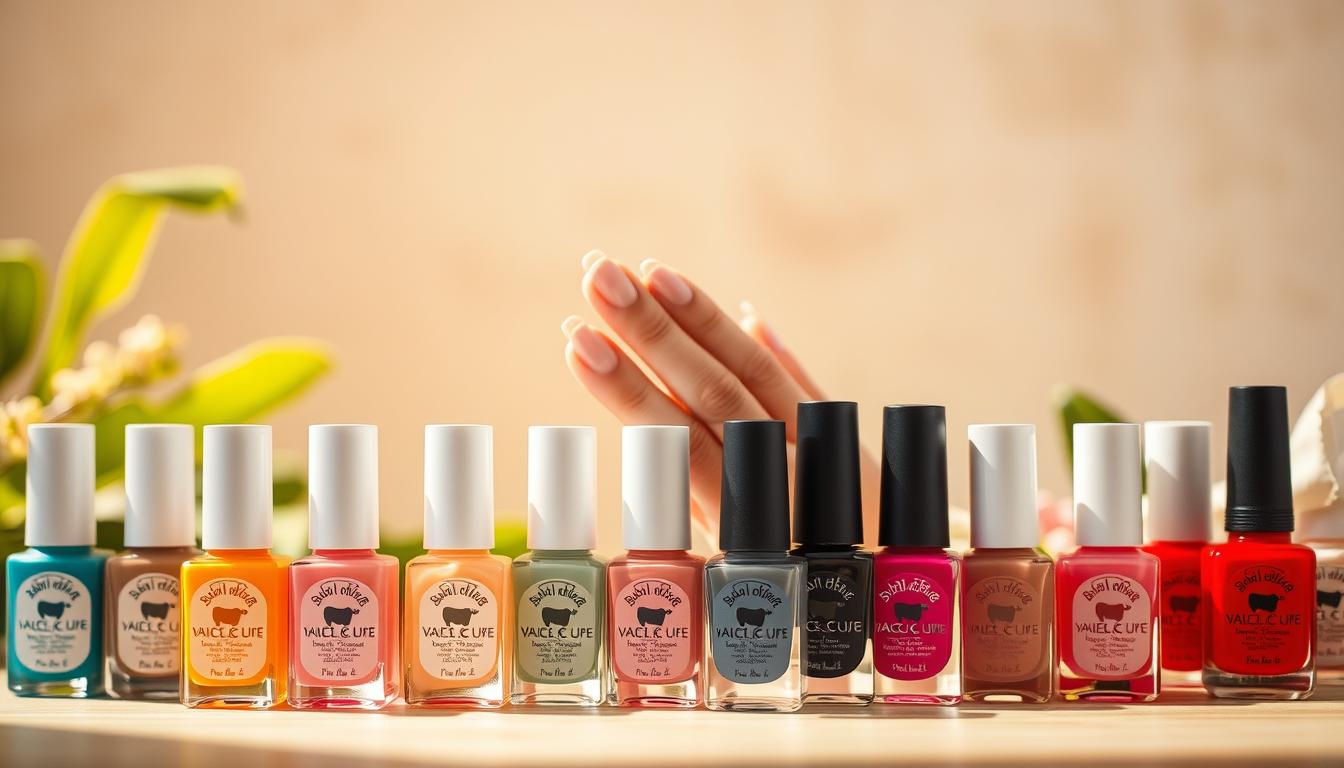Anúncios
Adopting a reptile-friendly lifestyle brings many benefits of reptiles. They are great for both families and people who love pets. These creatures help strengthen family dynamics with reptiles by building emotional connections with reptiles.
Reptiles are not just pets but also teach kids about responsibility. As families take care of these amazing animals, they learn to be empathetic and caring. This makes life better for both the families and their reptilian companions.
Popular Reptiles for Beginners
If you’re new to having reptiles, some species are especially great for kids and beginners. They have cool features that make them both good pets and fun for families.
Leopard Geckos: Perfect First Pets
Leopard geckos are top picks for first-time reptile owners because they’re calm and friendly. They need just a simple place to live, so they’re easy for kids to take care of. Their bright colors and spots are super attractive, helping kids feel close to them.
Bearded Dragons: Interactive Companions
Bearded dragons are great for beginners too. They like being around people, making them fun pets to have. Kids can handle them a lot, and they show friendly behaviors. This makes bearded dragons great for teaching kids about taking care of pets.
Corn Snakes: Docile and Easy to Care For
Corn snakes are perfect pets for kids because they’re gentle. They’re not hard to look after, which is good for beginners. Their cool looks and the way they act can really interest kids, teaching them about caring for animals. They’re also easy for parents to manage, making pet ownership easier for the whole family.

Embrace a Reptile-Friendly Lifestyle Today!
Creating a comfy space for your reptile is key to their well-being. A good habitat setup mirrors their natural home and supports their growth and health. Make sure to include the right temperature, humidity, and things to explore to help them thrive.
Creating a Comfortable Space for Reptiles
Start by choosing a suitable enclosure for your reptile’s needs. It should offer plenty of space to move and explore. You’ll need several key items for their home:
- Heating elements to maintain optimal temperature.
- Humidity controls to mimic natural conditions.
- Safe substrates that protect against ingestion hazards.
- Decorative yet functional items like rocks, plants, and climbing branches.
Adding these features will make the habitat look great and meet your reptile’s needs. A well-planned reptile environment is good for your pet and makes your space more inviting.
Nurturing Children’s Interest in Reptiles
Helping kids love reptiles opens up valuable learning moments. It teaches them to care and respect animals. Kids learn responsibility and grow emotionally and socially through this. It’s a way to safely introduce kids and reptiles.
Reptile Care Education for Kids
It’s important for kids to learn how to look after pets. Teaching them about reptile care shows them how to be kind and responsible. Things they should learn include:
- Daily care routines while monitoring health.
- Maintaining clean habitats that promote well-being.
- Recognizing signs of stress or illness.
Choosing Kid-Friendly Species
Choosing the right reptiles for kids can make a big difference. Some reptiles are gentle, which is great for kids. Some good choices are:
- Leopard geckos, known for their docile nature.
- Corn snakes, which are easy to handle and calm.
By emphasizing reptile education and picking friendly species, parents can build a lasting interest in children. This interest leads to a deeper understanding and care for these amazing creatures.
Building a Supportive Environment for Reptiles
Creating a good home for reptiles is key to their health and happiness. It’s important to make their living spaces similar to their natural environments. A well-set space meets their physical and mental needs.
Importance of Proper Habitat Setup
It’s critical to choose the right home for reptiles to help them flourish. Consider things like the right temperature, moisture, and hiding places. A well-thought-out space prevents health problems and supports their natural habits.
Essential Equipment for Reptile Care
Proper equipment is crucial for a reptile’s home. Some important items include:
- High-quality terrariums for different types of reptiles.
- UVB lighting for making vitamin D.
- Thermostats and hygrometers to keep an eye on the environment.
- Right substrates for digging or burrowing.
- Water dishes and heating pads for hydration and warmth.
Getting these essentials helps create a safe and fun home for reptiles. This makes their lives better.
Feeding and Nutrition for Your Reptile
Understanding what your reptile eats is key to keeping it healthy and happy. Every type of reptile has its own food needs. Knowing what these needs are helps ensure they get the right food.
Understanding Dietary Needs of Different Species
Reptile diets vary greatly. Some need lots of greens and veggies, while others need meat. It’s important to know this to prevent health problems.
Exploring Various Food Options
There are many kinds of food you can feed your reptile, such as:
- Insects like crickets and mealworms
- Fruits and vegetables for omnivorous species
- Specialized pellets designed for specific reptile types
- Live food for those species that thrive on it
Trying different foods helps meet your reptile’s nutritional needs. It also keeps them energetic and fun to engage with.
Social Interactions and Emotional Depth in Reptiles
Studies show that reptiles feel emotions like fear and anxiety. They can also form social bonds, showing they have deep feelings. This knowledge helps us take better care of them and build stronger bonds.
Recent Research on Reptile Emotions
Research has found reptiles show signs of emotions. They respond to what happens around them with feelings, not just instincts. This goes against old beliefs about reptiles, showing they have emotional depth.
The Importance of Social Bonds in Reptiles
Being close to other reptiles is key for their happiness. It makes them feel safe, lowering stress and making life better. We should make sure they can connect with others. This shows them love and helps them emotionally.
Integrating Reptiles into Family Life
Integrating reptiles into your family takes careful thought and positive steps. It’s really important to know how everyone feels, especially those a bit unsure. Starting with cozy, safe introductions at home can ease worries and make everyone more welcoming. Let’s explore some ways to make this journey go smoothly.
How to Introduce Reptiles to Family Members
To introduce reptiles safely, take slow steps. First, teach your family about the reptile’s kind. Important steps include:
- Showing pictures and videos of the reptile where it normally lives.
- Planning a calm, supervised meeting in a safe place.
- Letting family members ask questions and share what they think.
Tips for Encouraging Acceptance
To help your family warm up to reptiles, create positive moments and learn together. Some tips are:
- Point out what you can learn from reptiles and what makes them special.
- Get family involved in taking care of them, which helps build a connection.
- Talk about the emotional connection reptiles can provide as pets.
Reptiles as Alternative Companions
Exploring the world of reptiles leads to a deep appreciation for these creatures. Many people now consider reptiles as pets because of their unique traits. They are more than just exotic-looking; they offer several benefits making them great companions.
Advantages of Reptiles Over Traditional Pets
Reptiles can be an ideal choice for those with busy lives. They have several key advantages:
- They need less space than dogs or cats.
- They don’t need daily interaction, offering flexibility.
- Their care is simpler, with less cleaning and grooming.
When comparing reptiles to traditional pets, it’s clear they suit different lifestyles well. They bring a stress-free pet ownership experience while still keeping company.
The Unique Qualities of Reptiles
Reptiles have special features that make them fascinating. These include:
- Striking colors and patterns that draw attention.
- Interesting behaviors that vary among species.
- They offer a chance to learn and teach responsibility.
Looking after reptiles helps people bond over their love for these incredible creatures. Their uniqueness draws in those who want pets that give companionship and connect them to nature.
Sustainability and Conservation in a Reptile-Friendly Lifestyle
Having reptiles as pets is fun but comes with big responsibilities. These responsibilities help fight habitat loss and climate change effects on reptiles. By learning and sharing info, reptile lovers can help our planet.
Importance of Responsible Pet Ownership
Owning reptiles responsibly means knowing how to properly take care of them. This includes:
- Creating a home for them that feels like their natural habitat.
- Feeding them right and keeping them healthy.
- Understanding that they are a long-term commitment.
Owners who are well-informed and active help in reptile conservation. They also make sure their pets are happy and healthy.
Supporting Reptile Conservation Initiatives
Helping with conservation efforts is vital for reptiles’ survival. Reptile owners can help by:
- Joining local programs that fix damaged habitats.
- Giving money to groups that work on saving reptiles.
- Encouraging eco-friendly habits in their own neighborhoods.
These efforts not only help reptiles but show how our choices impact the environment. It’s a great way to enjoy reptiles and do good for the Earth.
Challenges of a Reptile-Friendly Lifestyle
Choosing a reptile-friendly lifestyle is exciting but comes with challenges. Reptile misconceptions are widespread, affecting how people see these pets. To live happily with reptiles, learning about them and teaching others is key.
Common Misconceptions about Reptiles
Many believe things about reptiles that aren’t true, making them hesitate to care for these animals. Some of these false beliefs include:
- Reptiles are cold-blooded and lack emotions.
- All reptiles are dangerous and should be feared.
- Reptiles require minimal care compared to traditional pets.
These wrong ideas stop people from seeing the real wonders of these animals. Telling the truth about reptiles can help people understand and take care of them rightly.
Addressing Fears and Concerns
Getting over fear of reptiles needs time and learning about them. Here’s how potential reptile owners can start:
- Participate in local reptile exhibitions or educational events.
- Engage in conversations with experienced reptile owners.
- Visit reptile rescue centers to observe and learn about caring for these animals.
These steps can help people know more about reptiles and feel better about owning them. This way, families can face the challenges of having reptiles and enjoy their company.
Conclusion
Having reptiles as pets brings many benefits. These include better family bonds, learning chances, and deeper emotional ties. Learning to care for reptiles can really make our lives richer. It lets us see just how special these pets are.
Thinking about getting a reptile? Remember it’s both fun and a big responsibility. You’ll need to create the right home for them, feed them properly, and spend time with them. This not only makes their lives better but also teaches us kindness and understanding.
Caring for a reptile can enrich your life. It teaches you to be responsible and helps you grow. As more people see the value in reptiles, it’s important to promote responsible pet ownership. This way, we can all enjoy a life that’s friendly to reptiles.



